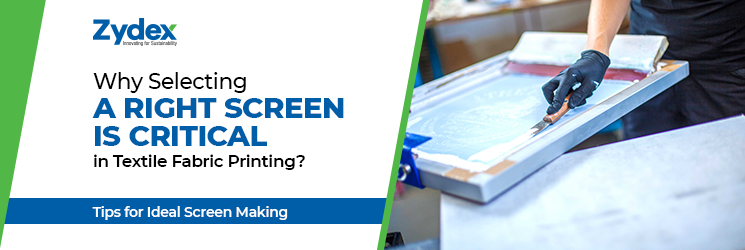Screen printing is one of the most popular printing techniques used in a wide range of industries, including textiles. It is the process of pressing ink through a stenciled mesh screen to create a printed design. Special screen printing ink or water-based printing ink are used in this technique. The core of the screen printing process involves a fine mesh or screen, which is the most crucial part of the printing process. A small difference in the screen can make or break your brand due to the quality of the print. Consequently, it is salient to select and create an ideal screen for printing.
Before we talk about screens, it is important to know the concept of mesh count. A screen is nothing but a fiber cloth. Mesh count of a screen indicates the number of fibers present in one square inch of the fabric. A mesh count of 110T means 110 fiber threads are present in one square inch of the fabric. Mesh count varies from one fabric to another fabric. Generally, it starts with 40T fabric and goes up to 200T. Lower mesh count indicates an open or coarser screen, while higher mesh counts are denser and have lesser openings between them. This means lower the mesh count higher will be the ink deposition through screen leading to heavy or bulk deposition and higher the mesh count lesser will be the screen print ink deposition leading to finer prints. The mesh count may also affect the feel of the printed substrate. Therefore it is important to select an ideal screen mesh for good quality printing.
CHOOSING THE RIGHT MESH FOR YOUR SCREEN
25T – 40T Mesh: They are used for large particle size inks such as glitter paste, pearl paste, etc. The coarser mesh will allow the glitter particles to pass easily through the substrate, thereby leading to heavy ink deposition.
40T – 60T Mesh: Use them for finer glitter design where the particle size is 8mm and below.
80T – 110T Mesh: They are used for speciality printing inks such as puff, silicon ink etc. The design of speciality print may vary from line to blotch dots. Select screen size as per the design.
110T – 160T Mesh: They are the most commonly used screen meshes for printing. Screens on the lower end of the mesh count spectrum put down heavier ink deposits and are ideal for printing under bases or printing bold colors on dark fabrics. At the higher end of the mesh count spectrum, you can print a more detailed image while maintaining a fair ink deposit.
160T Mesh and above: Screens beyond 160 mesh count are used for printing finer print designs giving a sharper look and softer feel. Inks are prone to choking in these screen meshes when they tend to dry. Make sure to select ink having a slower drying profile. You can add retarder whenever required to avoid screen choking.
TIPS FOR IDEAL SCREEN MAKING:
-
-
- Use yellow color (dyed) fabric for high mesh counts to get good exposing as white fabric scatter more light leading to under-exposing of screens.
- Stretch the bolting cloth and leave it for 15 minutes. Let the bolting cloth relax in between stretching. Stretch the bolting cloth again till it is tight enough.
- Use tension meter every time while a screen cloth is bolted. Try to keep the tension in between 25 to 30 N/cm for better print results. A loose screen may give uneven ink deposition on the substrate.
- Attach the fabric to the frame with the use of epoxy type adhesive only.
- Measure the tension with the help of tension meter in both the directions at all measuring points (25 TO 30 N/CM)
- During screen exposing use a silver foil on the inner sidewall of the exposing table to get more exposure.
- Exposing table surface should be clean. There should not be any scratches on the glass surface.
- Use exposure calculators for measuring the time of exposure. Over and under exposure would affect your final print. For finer mesh counts keep exposing time a bit longer than usual time.
- The emulsion coating must be performed in the darkroom under extremely stringent conditions. No extraneous light can be allowed into the room.
- Use automatic emulsion coater so that the emulsion is spread evenly. Uneven emulsion coating will lead to uneven printing on the substrate.
-
The steps mentioned above will ensure that the screen is flawless and will be ideal for printing.







